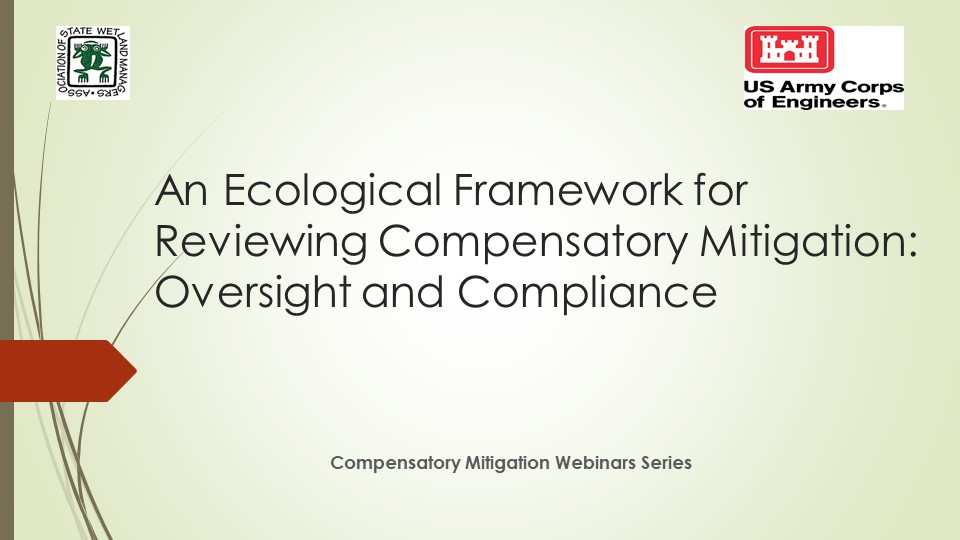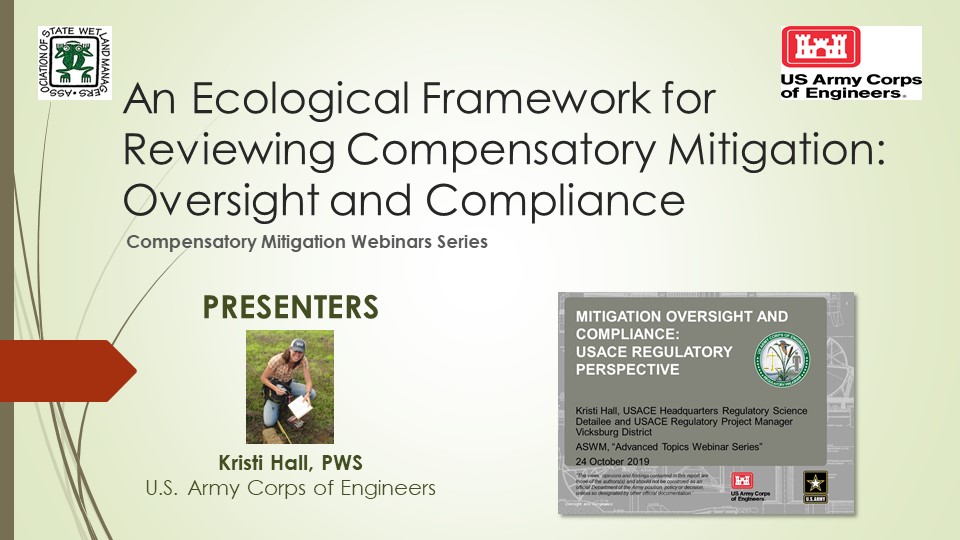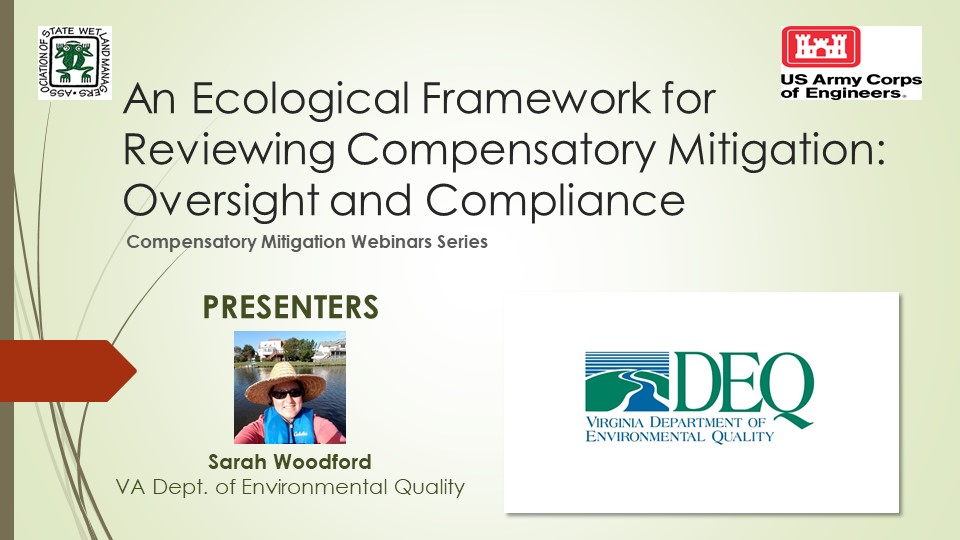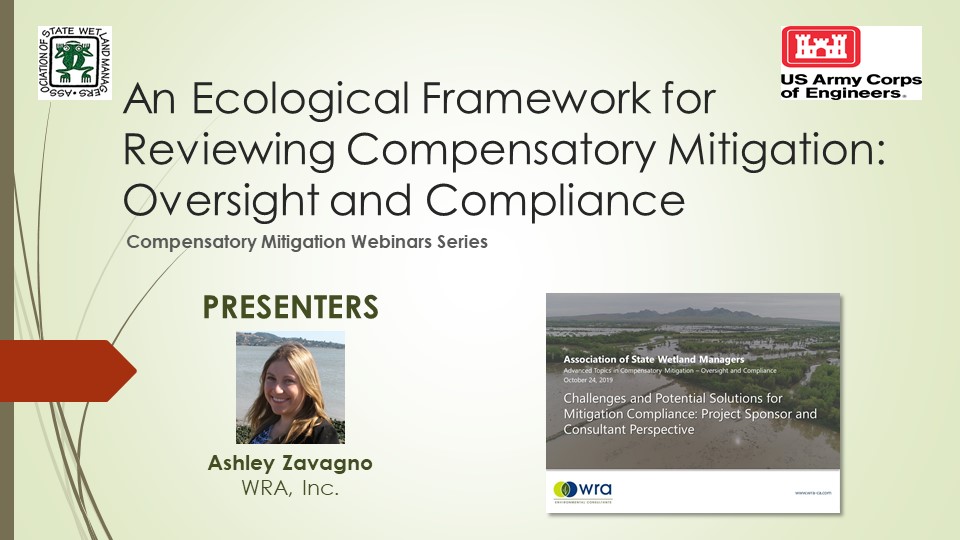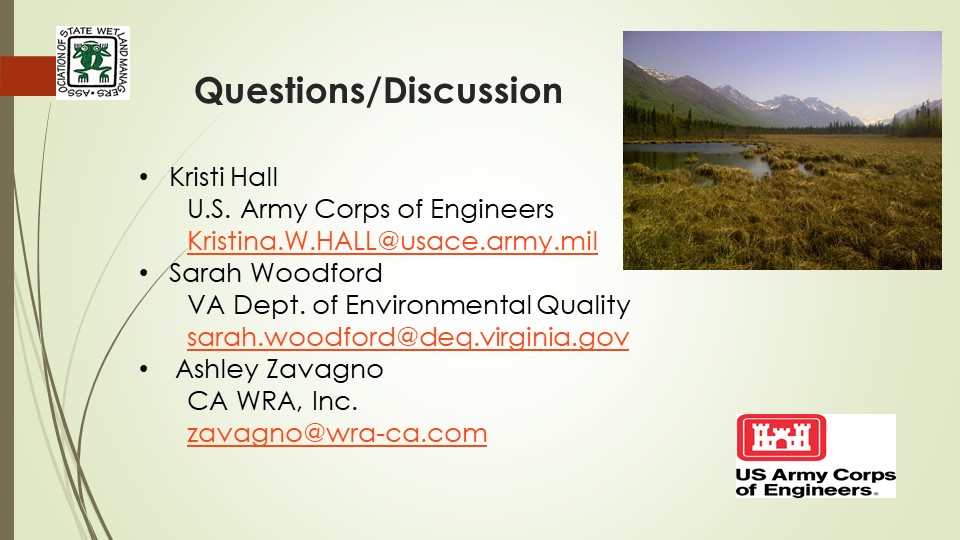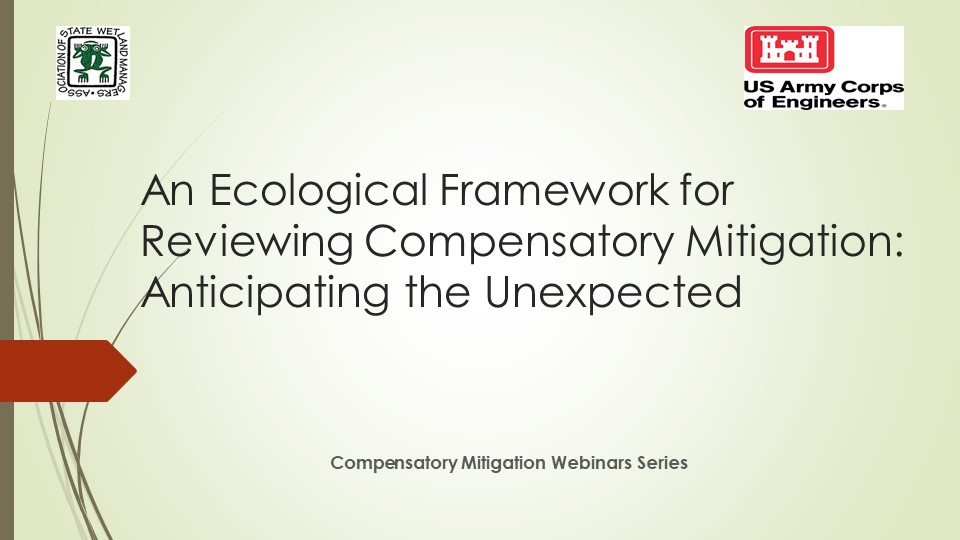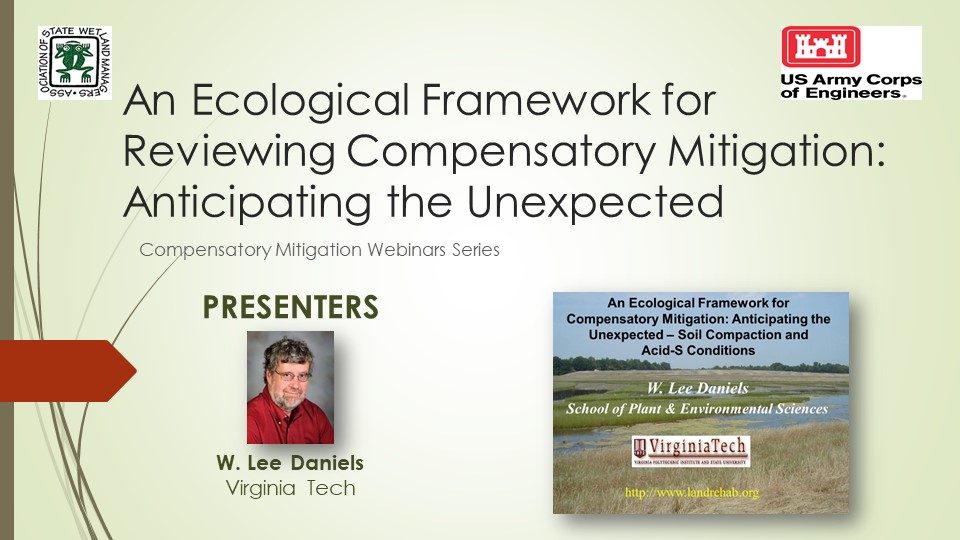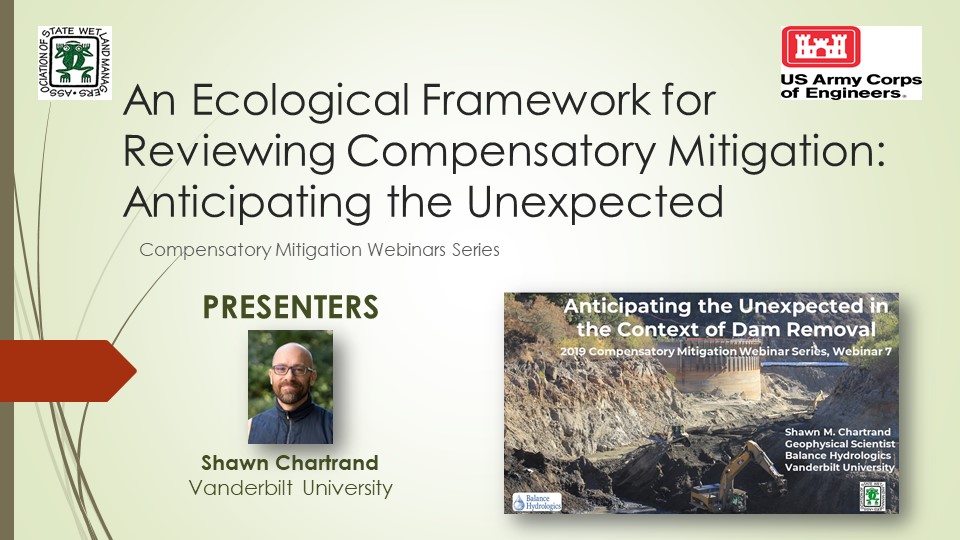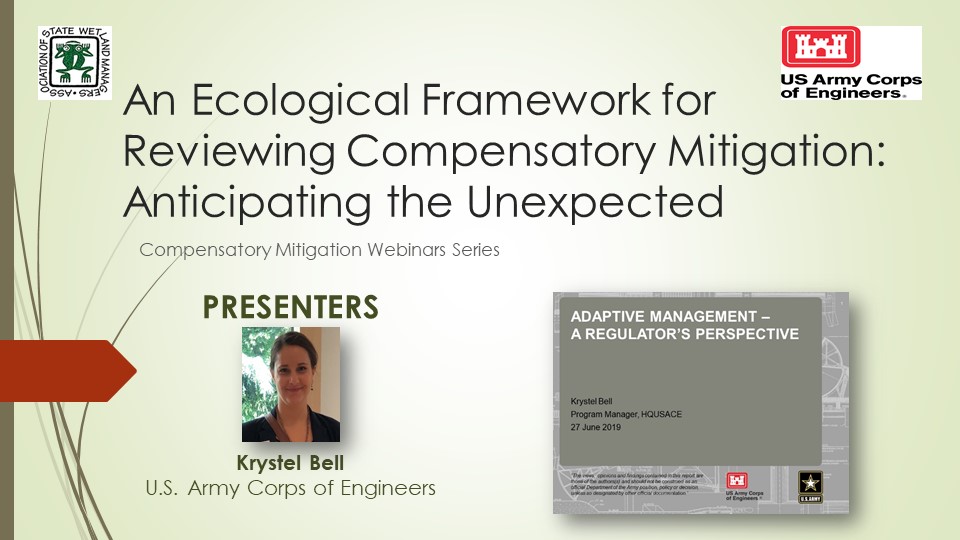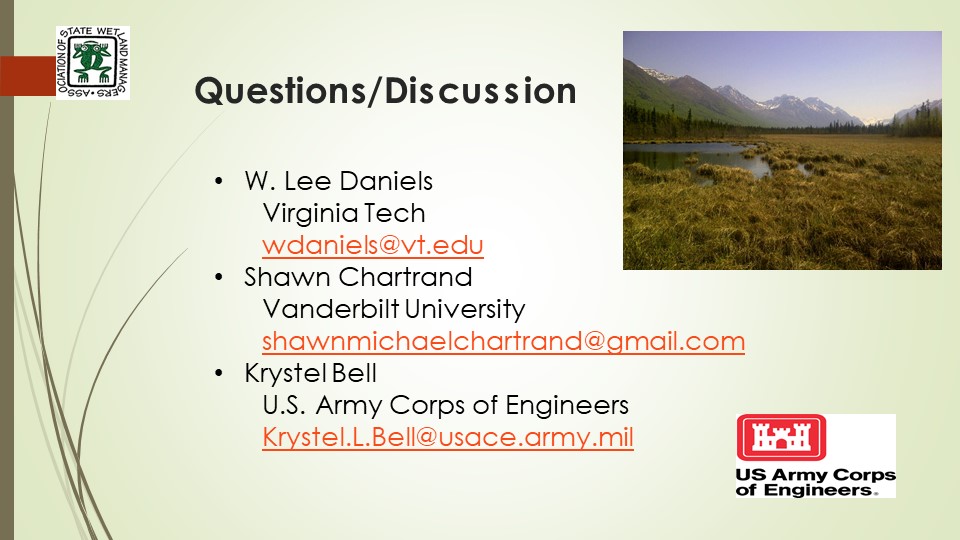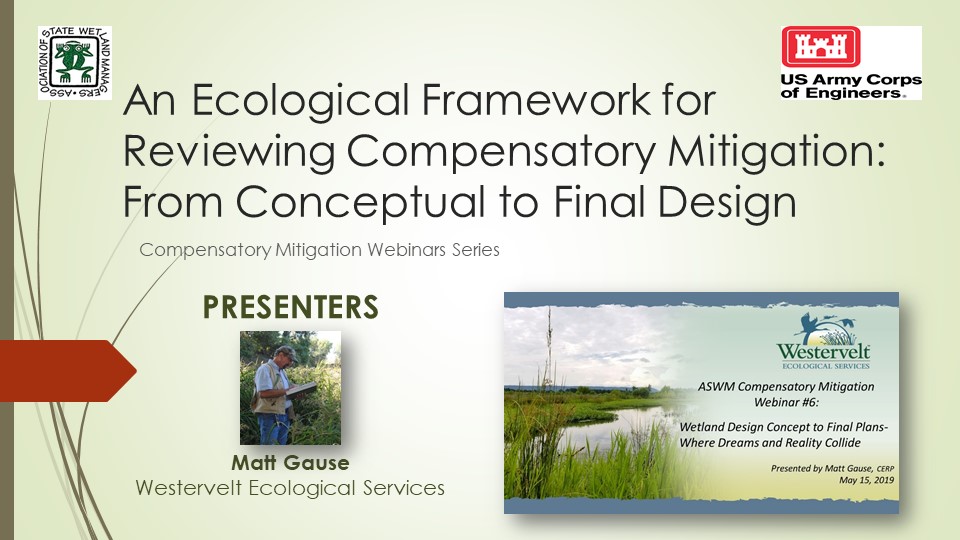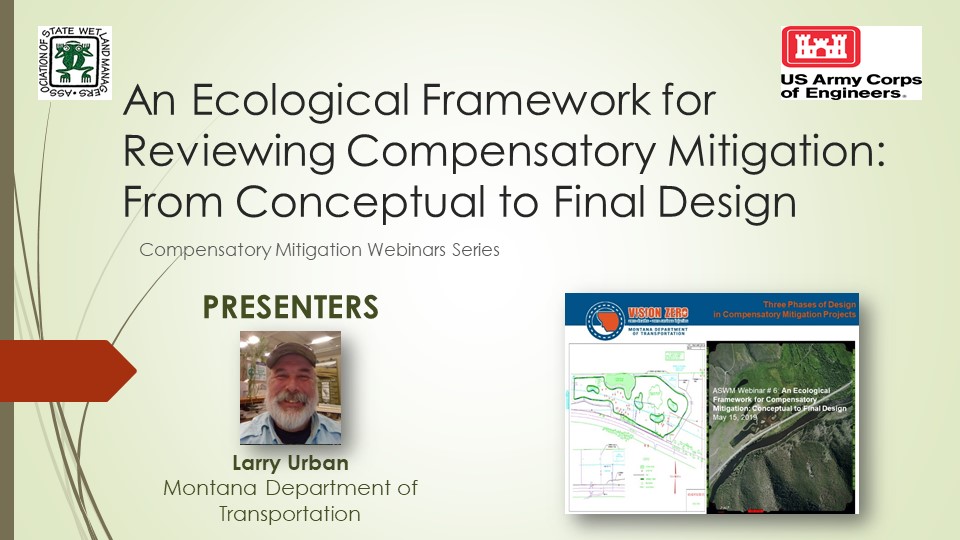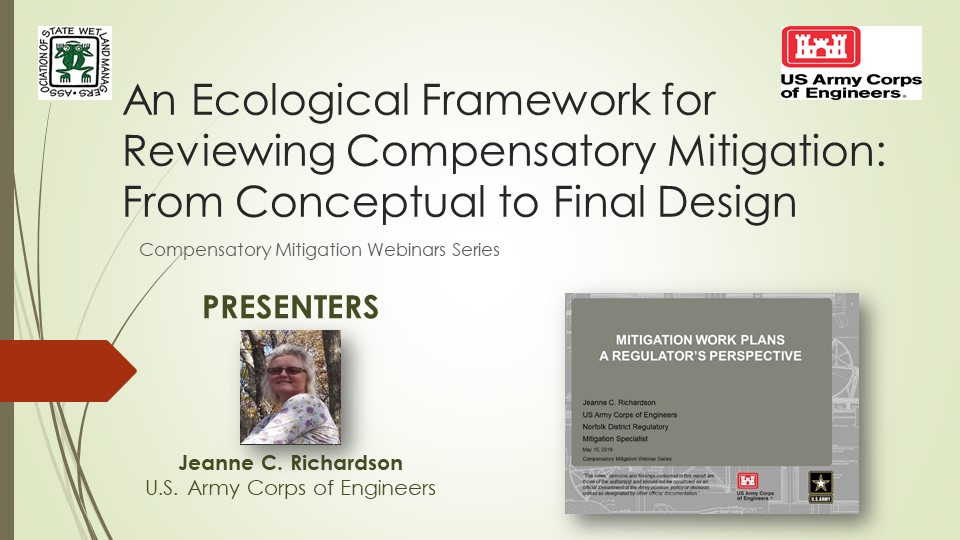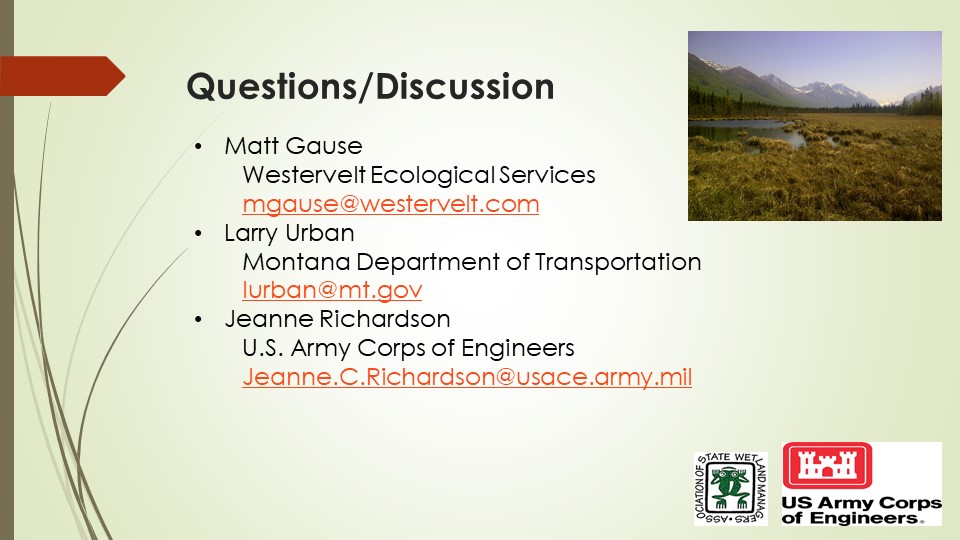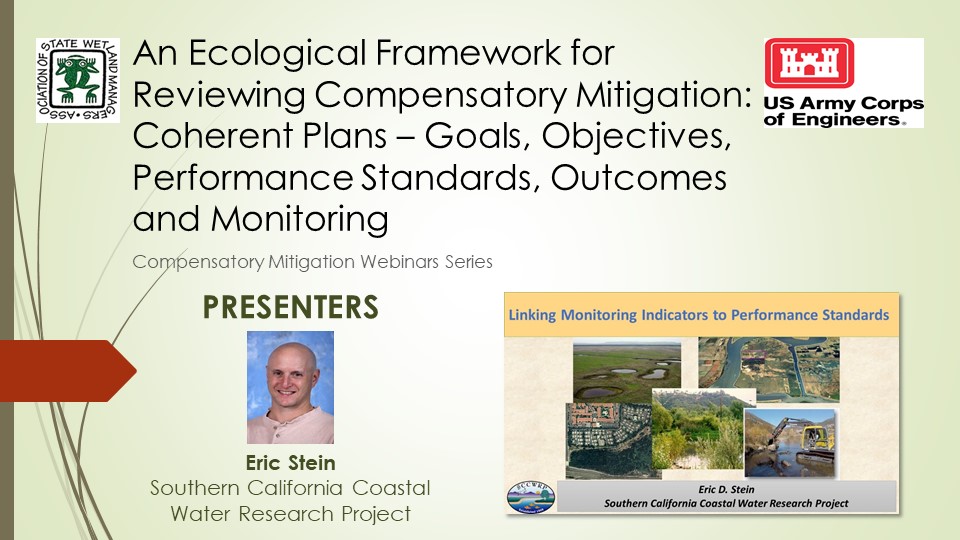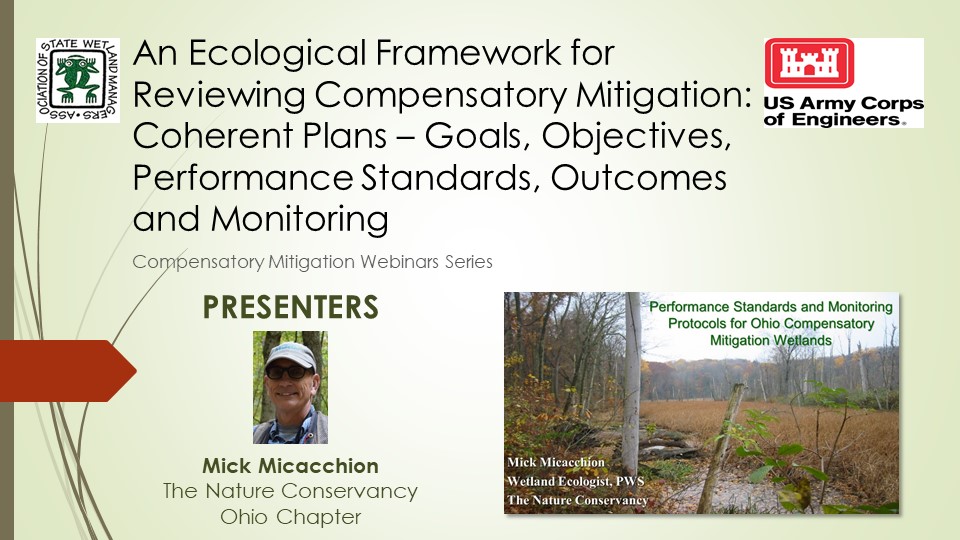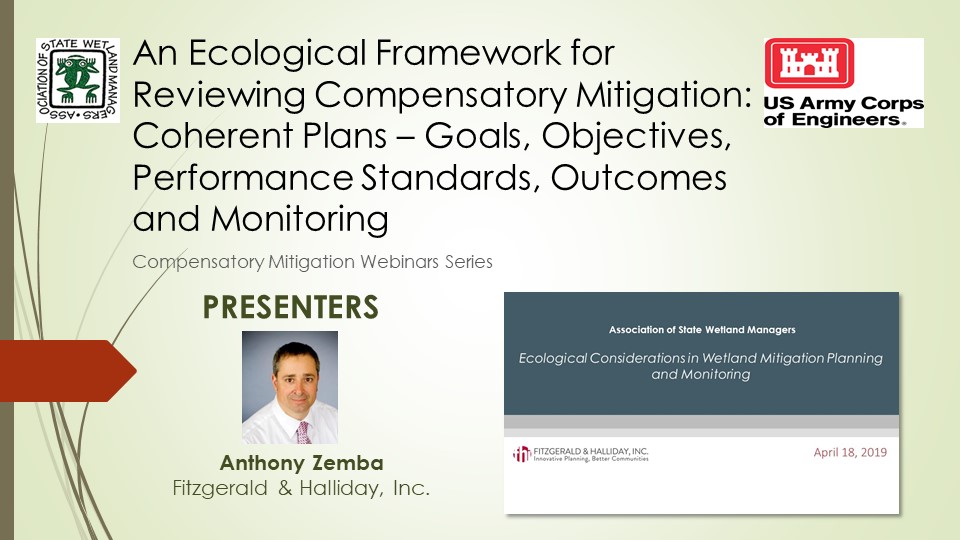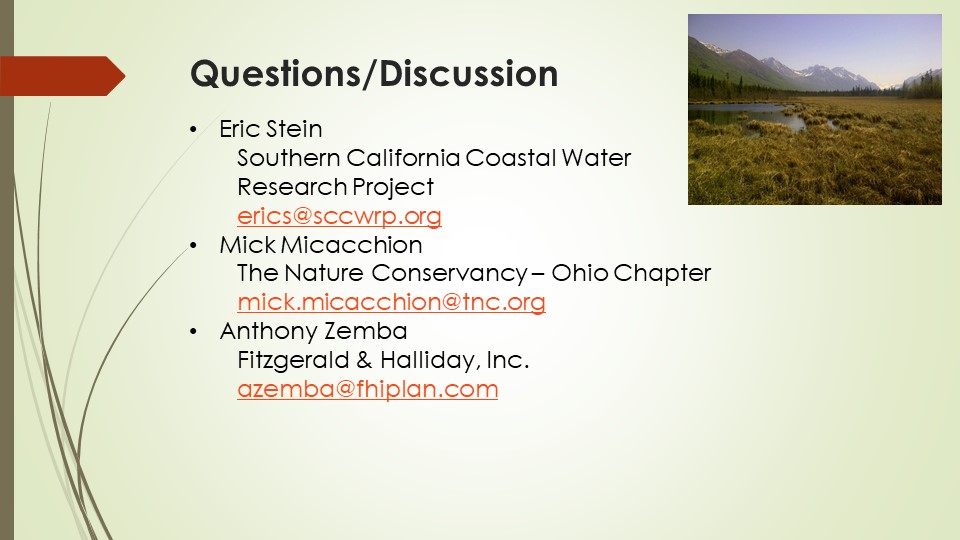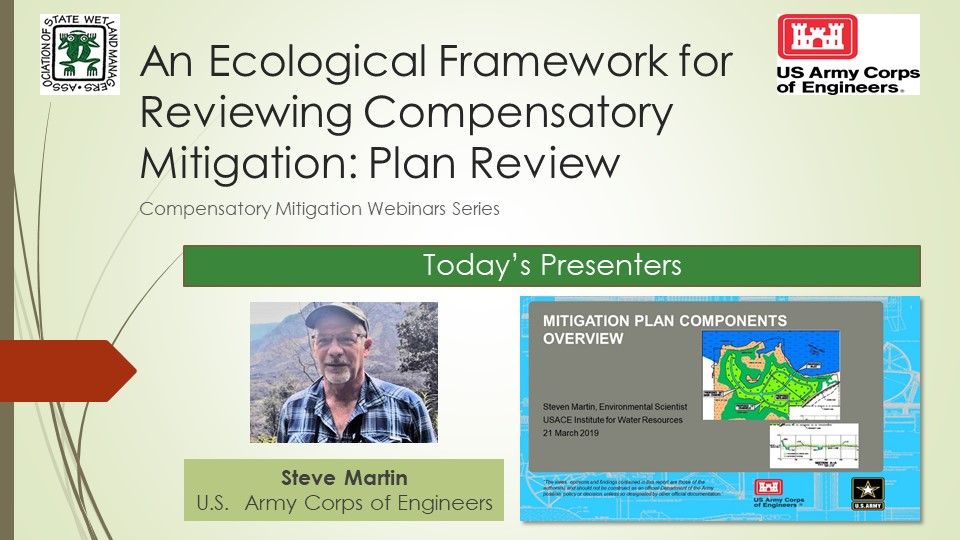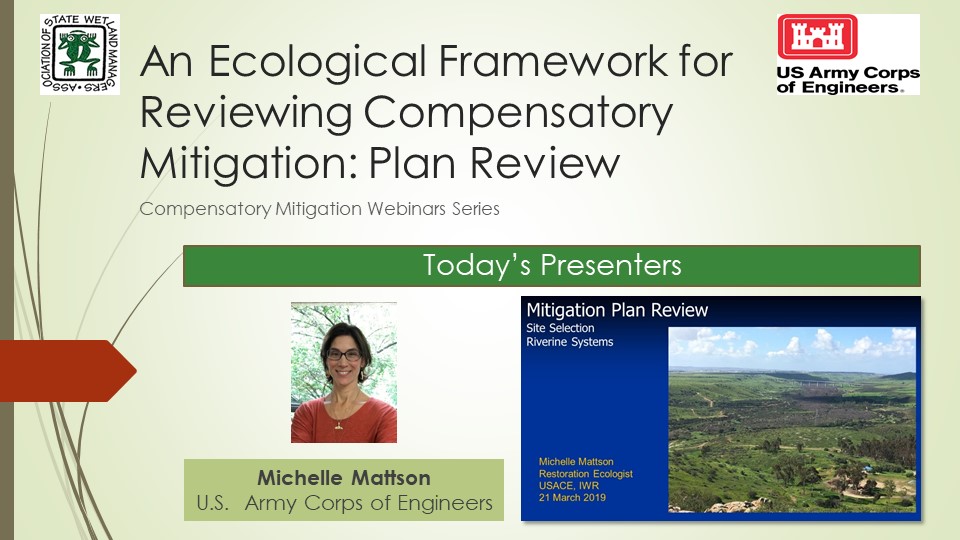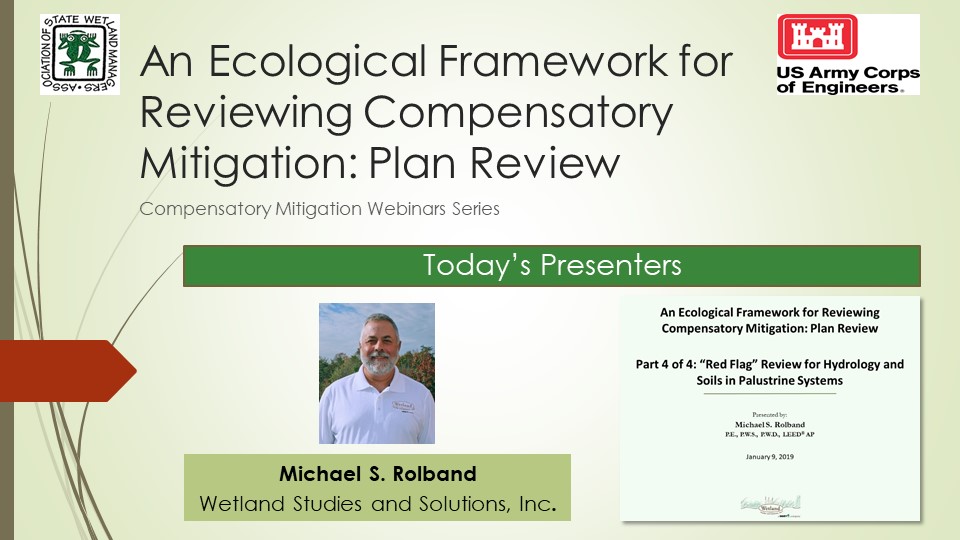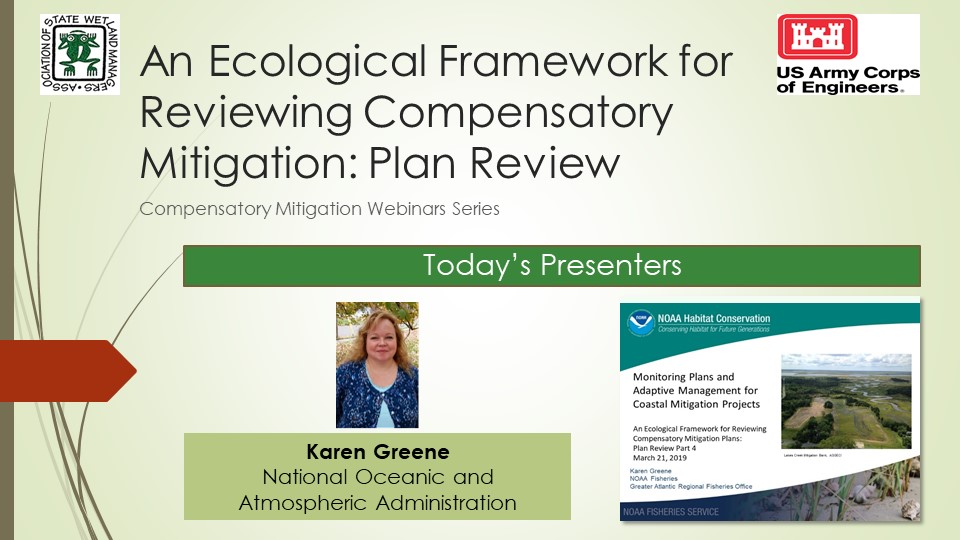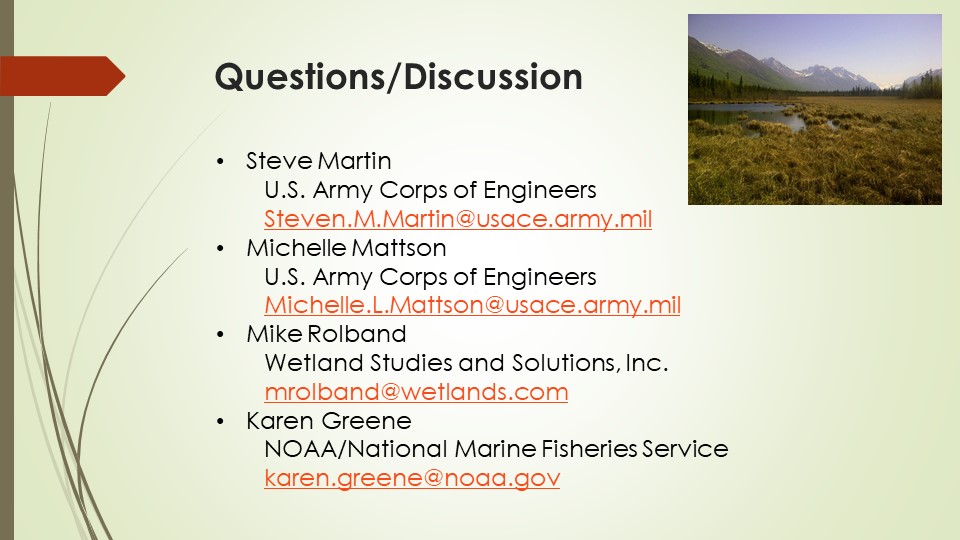Webinar 8: An Ecological Framework for Reviewing Compensatory Mitigation: Oversight and Compliance
Held Thursday, October 24, 2019 - 2:00pm – 4:30pm Eastern
INTRODUCTION
Marla Stelk, Executive Director, National Association of Wetland Managers [POWERPOINT PRESENTATION]
PRESENTERS
- Kristina Hall, U.S. Army Corps of Engineers [POWERPOINT PRESENTATION]
- Sarah Woodford, Virginia Department of Environmental Quality [POWERPOINT PRESENTATION]
- Ashely Zavagno, CA WRA, Inc. [POWERPOINT PRESENTATION]
ABSTRACTS
Kristina Hall
Oversight and compliance is an important component of compensatory mitigation. This presentation will discuss oversight and compliance from the perspective of a Corps Regulator as well as important “touch points” in mitigation plan review, approval, implementation, monitoring and long term management. Examples of effective adjustment of anticipated outcomes will be given and along with flexibility in the Regulatory’s oversight of the compensatory mitigation process.
Sarah Woodford
Oversight and compliance are essential components of any functional regulatory program. This presentation discusses oversight tools that are used in Virginia in the regulation of mitigation banks and in-lieu fee programs. In addition, through several case studies, the presentation will provide a state perspective of the communication and resolutions that developed when non-compliance or other issues were identified.
Ashley Zavagno
Oversight and compliance challenges in compensatory mitigation are different for project sponsors and consultants than for regulators. This presentation will explore challenges faced by project sponsors and consultants during the development, implementation, monitoring, and long-term management stages of mitigation projects and offer potential solutions and best management practices. Such challenges include implementing complex performance standards for multiple agencies, finding appropriate easement and endowment holders, disparity in endowment requirements across projects, coordinating decisions with multiple parties during implementation, and lack of collaboration between agencies and project proponents during project development.
BIOS
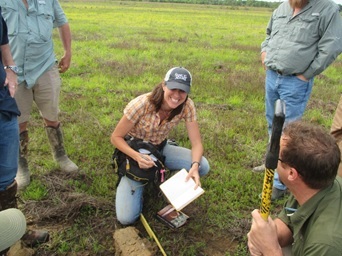 Kristi Hall, Professional Wetland Scientist, is currently the USACE Regulatory Headquarters Science Detailee. When not on detail assignment, she is a Senior Environmental Scientist with the Vicksburg District Regulatory Branch, Evaluation Section. At the District, Kristi primarily focuses on mitigation banking and standard permitting. Kristi has worked in the Regulatory field since 2003 and has been with the Vicksburg District since 2015. She obtained her bachelor’s degree in biochemistry from Virginia Tech and her master’s degree in fisheries and wildlife biology from Colorado State University. Kristi has worked in both the public and private sectors with the Mississippi Department of Transportation, USACE ERDC Environmental Lab, as well as several private consulting firms prior to working with USACE Regulatory. Kristi served as Acting Technical Services Branch Chief in the Nashville District in 2017 and was named the 2018 Vicksburg District Regulator of the Year. In her “free time” she can be found shuttling her two kids to their numerous athletic endeavors, and working with her husband to build their own home in Vicksburg.
Kristi Hall, Professional Wetland Scientist, is currently the USACE Regulatory Headquarters Science Detailee. When not on detail assignment, she is a Senior Environmental Scientist with the Vicksburg District Regulatory Branch, Evaluation Section. At the District, Kristi primarily focuses on mitigation banking and standard permitting. Kristi has worked in the Regulatory field since 2003 and has been with the Vicksburg District since 2015. She obtained her bachelor’s degree in biochemistry from Virginia Tech and her master’s degree in fisheries and wildlife biology from Colorado State University. Kristi has worked in both the public and private sectors with the Mississippi Department of Transportation, USACE ERDC Environmental Lab, as well as several private consulting firms prior to working with USACE Regulatory. Kristi served as Acting Technical Services Branch Chief in the Nashville District in 2017 and was named the 2018 Vicksburg District Regulator of the Year. In her “free time” she can be found shuttling her two kids to their numerous athletic endeavors, and working with her husband to build their own home in Vicksburg.
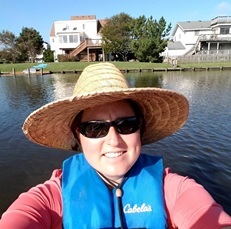 Sarah Woodford is the Compensatory Mitigation Specialist for the Virginia Department of Environmental Quality. She is the state chair of the Interagency Review Team for all non-tidal wetland and stream mitigation banks and in-lieu fee programs in the U.S. Army Corps of Engineers Norfolk District, and ensures that mitigation sponsors adhere to State Water Control Law and Virginia Water Protection Permit Program regulations. Sarah works closely with the Corps and the Virginia Marine Resources Commission IRT chairs, along with other member agencies of the IRT, to reach consensus on complex issues in compensatory mitigation. She also assists permit managers, mitigation sponsors, consultants, and the regulated public in understanding the mitigation process. Prior to DEQ, Sarah worked as an environmental consultant, where she focused on water quality monitoring and stream mitigation assessment, restoration design, and post-construction performance monitoring.
Sarah Woodford is the Compensatory Mitigation Specialist for the Virginia Department of Environmental Quality. She is the state chair of the Interagency Review Team for all non-tidal wetland and stream mitigation banks and in-lieu fee programs in the U.S. Army Corps of Engineers Norfolk District, and ensures that mitigation sponsors adhere to State Water Control Law and Virginia Water Protection Permit Program regulations. Sarah works closely with the Corps and the Virginia Marine Resources Commission IRT chairs, along with other member agencies of the IRT, to reach consensus on complex issues in compensatory mitigation. She also assists permit managers, mitigation sponsors, consultants, and the regulated public in understanding the mitigation process. Prior to DEQ, Sarah worked as an environmental consultant, where she focused on water quality monitoring and stream mitigation assessment, restoration design, and post-construction performance monitoring.
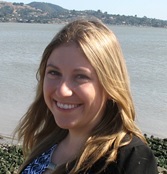 Ashley Zavagno is a Restoration Ecologist and Project Manager at WRA, Inc., a private environmental consulting firm based in the San Francisco Bay Area. She received her Bachelor of Science in Ecology and Evolution from U.C. Santa Barbara and her Master of Environmental Science and Management with a specialization in conservation planning from the Bren School of Environmental Science & Management. She is also a Certified Ecological Restoration Practitioner through the Society of Ecological Restoration and a Certified Ecologist through the Ecological Society of America. For the past several years, she has been overseeing the entitlement, permitting, implementation, monitoring, and long-term management of various mitigation banks and large-scale permittee-responsible mitigation projects throughout California. She has worked in various western landscapes including tidal wetlands, vernal pools, chaparral, coniferous forests, and oak woodlands, but her passion is rivers and salmonids.
Ashley Zavagno is a Restoration Ecologist and Project Manager at WRA, Inc., a private environmental consulting firm based in the San Francisco Bay Area. She received her Bachelor of Science in Ecology and Evolution from U.C. Santa Barbara and her Master of Environmental Science and Management with a specialization in conservation planning from the Bren School of Environmental Science & Management. She is also a Certified Ecological Restoration Practitioner through the Society of Ecological Restoration and a Certified Ecologist through the Ecological Society of America. For the past several years, she has been overseeing the entitlement, permitting, implementation, monitoring, and long-term management of various mitigation banks and large-scale permittee-responsible mitigation projects throughout California. She has worked in various western landscapes including tidal wetlands, vernal pools, chaparral, coniferous forests, and oak woodlands, but her passion is rivers and salmonids.
![]()
Webinar 7: An Ecological Framework for Compensatory Mitigation: Anticipating the Unexpected
Held Thursday, June 27, 2019 - 2:00pm – 4:30pm Eastern
![]()
INTRODUCTION
Marla Stelk, Executive Director, National Association of Wetland Managers [POWERPOINT PRESENTATION]
PRESENTERS
- W. Lee Daniels, Thomas B. Hutcheson Professor of Environmental Soil Science, Virginia Tech [POWERPOINT PRESENTATION]
- Shawn Chartrand, Postdoctoral Research Fellow, Vanderbilt University [POWERPOINT PRESENTATION]
- Krystel Bell, Regulatory Program Manager, U.S. Army Corps of Engineers [POWERPOINT PRESENTATION]
ABSTRACTS
W. Lee Daniels
Compaction of created wetland subsoils is often required for stability and to limit groundwater losses, but failure to provide a suitably loosened surface soil rooting media is a common problem, particularly for deeper rooted forested wetlands. Remedies include managing soil placement and tillage operations in concert with seasonal/moisture constraints. Near-surface compaction can also drastically alter hydroperiod regimes away from intended target references. Deeper excavations of creation sites in the mid-Atlantic USA also commonly encounter potential acid-sulfate materials, which if allowed to oxidize, generate very low soil+water pH and phytotoxic conditions. Preconstruction testing, recognition and avoidance are critical; remedial measures include heavy liming and organic amendments and/or keeping these materials saturated year-round.
Shawn Chartrand
Wetland and fluvial restoration projects commonly include post-construction plans which detail actions to address issues related to routine maintenance, adaptive management and remediation. These three direct actions have one common goal: set the constructed project on a trajectory to realize the restoration objectives. In this webinar they reviewed these three direct actions, with an emphasis on (1) how the direct actions are typically differentiated during the pre-construction planning and design phase, (2) post-construction conditions that are difficult to anticipate and therefore plan around, and (3) strategies that can be used to address significant uncertainties involving future landscape conditions. They reviewed the San Clemente Dam Removal project to help illustrate routine maintenance, adaptive management and remediation, within the context of an action that will reset the Carmel River corridor to a new physical state.
Krystel Bell
This presentation provided an understanding of the Corps' perspective in review, approval, and oversight of mitigation projects where adaptive management has been used as an important tool for planning and response to challenges and unforeseen changes to those projects.
BIOS
 W. Lee Daniels is the Thomas B. Hutcheson Professor of Environmental Soil Science at Virginia Tech in Blacksburg, Virginia. He received his Ph.D. in Soil Science from VPI & SU in 1985. Dr. Daniels areas of specialization include stabilization and restoration of disturbed lands including areas disturbed by mining, road building, waste disposal, urbanization and erosion. In particular, he has focused his research and consulting experience in wetland impact mitigation, mine reclamation, and soil-waste management systems. His teaching programs at Virginia Tech focus on soil geomorphology and landscape analysis with particular emphasis on the relationships among surficial geology, hydrology, soil patterns and long term landscape evolution processes. Major awards include the Reclamation Researcher of the Year by the American Society for Surface Mining and Reclamation (ASMR) in 1993, USEPA’s National Biosolids Utilization Research Award in 2000 and the Lifetime Achievement in Research Award by ASMR in 2012.
W. Lee Daniels is the Thomas B. Hutcheson Professor of Environmental Soil Science at Virginia Tech in Blacksburg, Virginia. He received his Ph.D. in Soil Science from VPI & SU in 1985. Dr. Daniels areas of specialization include stabilization and restoration of disturbed lands including areas disturbed by mining, road building, waste disposal, urbanization and erosion. In particular, he has focused his research and consulting experience in wetland impact mitigation, mine reclamation, and soil-waste management systems. His teaching programs at Virginia Tech focus on soil geomorphology and landscape analysis with particular emphasis on the relationships among surficial geology, hydrology, soil patterns and long term landscape evolution processes. Major awards include the Reclamation Researcher of the Year by the American Society for Surface Mining and Reclamation (ASMR) in 1993, USEPA’s National Biosolids Utilization Research Award in 2000 and the Lifetime Achievement in Research Award by ASMR in 2012.
 Shawn Chartrand completed his PhD at the University of British Columbia, and he is presently a postdoctoral research fellow at Vanderbilt University. Shawn is interested in how mountain streams form and evolve due to changes in local to watershed scale conditions. He uses laboratory experiments, develops theory, numerical models as well as field-based programs to pursue his interests, and develop strategies to assist practitioners working on applied problems. He has worked professionally for Balance Hydrologics since 2000, during which time he built and continues to lead a river and wetland restoration program. His notable applied experience includes 8 years of work on the San Clemente Dam Removal project, Carmel River, CA, and 15 years of work using climate change projections to plan water supply and instream flows for salmonids with the City of Santa Cruz and other regional Cities.
Shawn Chartrand completed his PhD at the University of British Columbia, and he is presently a postdoctoral research fellow at Vanderbilt University. Shawn is interested in how mountain streams form and evolve due to changes in local to watershed scale conditions. He uses laboratory experiments, develops theory, numerical models as well as field-based programs to pursue his interests, and develop strategies to assist practitioners working on applied problems. He has worked professionally for Balance Hydrologics since 2000, during which time he built and continues to lead a river and wetland restoration program. His notable applied experience includes 8 years of work on the San Clemente Dam Removal project, Carmel River, CA, and 15 years of work using climate change projections to plan water supply and instream flows for salmonids with the City of Santa Cruz and other regional Cities.
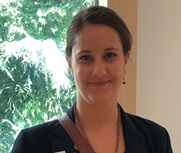 Krystel Bell recently became Regulatory Program Manager for the U.S. Army Corps of Engineers in Washington, D.C. Prior to this, she served as Mitigation Banking Specialist for the Sacramento District of the U.S. Army Corps of Engineers where she chaired the Interagency Review Team for multiple mitigation banks and in-lieu fee programs and worked on several of the District’s most complex regulatory actions. Prior to working for the Sacramento District, Ms. Bell worked as an environmental consultant and acted as a local representative for a County‐ level environmental program. Ms. Bell has extensive knowledge of how Regulatory decisions can affect developers, conservationists, and the general public. Her ability to communicate effectively with applicants, the public, federal, state and local agencies, and peers in the regulatory community has led to productive collaborative approaches in resolution of complex regulatory issues.
Krystel Bell recently became Regulatory Program Manager for the U.S. Army Corps of Engineers in Washington, D.C. Prior to this, she served as Mitigation Banking Specialist for the Sacramento District of the U.S. Army Corps of Engineers where she chaired the Interagency Review Team for multiple mitigation banks and in-lieu fee programs and worked on several of the District’s most complex regulatory actions. Prior to working for the Sacramento District, Ms. Bell worked as an environmental consultant and acted as a local representative for a County‐ level environmental program. Ms. Bell has extensive knowledge of how Regulatory decisions can affect developers, conservationists, and the general public. Her ability to communicate effectively with applicants, the public, federal, state and local agencies, and peers in the regulatory community has led to productive collaborative approaches in resolution of complex regulatory issues.
Webinar 6: An Ecological Framework for Reviewing Compensatory Mitigation: From Conceptual to Final Design
Held Wednesday, May 15, 2019 - 2:00 p.m. ET
INTRODUCTION
- Dawn Smith, National Association of Wetland Managers [POWERPOINT PRESENTATION]
PRESENTERS
- Matt Gause, Ecological Resources & Land Stewardship Director, Westervelt Ecological Services
[POWERPOINT PRESENTATION] -
Larry Urban, Wetland Mitigation Specialist, Montana Department of Transportation
[POWERPOINT PRESENTATION] -
Jeanne Richardson, Mitigation Subject Matter Expert, U.S. Army Corps of Engineers, Norfolk District Regulatory Branch
[POWERPOINT PRESENTATION]
ABSTRACTS
Matt Gause
Wetland Mitigation Concept to Final Design – Where Dreams and Reality Collide
The value of good data on both biotic and abiotic elements was emphasized in earlier webinars in this series. Good biotic and abiotic data also forms the foundation of the mitigation conceptual design; however, all the data necessary to finalize the design is often not yet available when a conceptual mitigation plan is first presented to regulatory agency staff. Using selected case studies this webinar identified general best practices for evaluating conceptual designs, illustrate how designs become more refined as new information comes to light and how to best remain engaged in the design process while working towards a final, implementable design.
Larry Urban
Three Phases of Design in Compensatory Mitigation Projects
Mitigation projects generally follow a three-phased approach to design prior to construction and implementation on the ground. These phases consist of Conceptual, Preliminary, and Final Design efforts. The Conceptual phase focuses on developing a series of Concepts / Options and then determining the feasibility of developing a mitigation project. These initial conceptual phases are important in provides an opportunity for cooperative agency review and input towards the selection of an approved “Preferred” concept. However, that “Preferred” concept may or may not move forward into more detailed design based upon cost/benefit analysis. Preliminary Design phase is where the details of a “Preferred” concept selected evolves thru a design process towards the development of construction plans. It involves agency review that may involve revisions to the details of the “Preferred” design as it moves forward towards construction. The Final Design is essentially that, to finalize the construction plans and specifications of a mitigation project for construction efforts. The Final Design involves agency review of the details of the project but does not involve major changes to the design that would delay construction or prevent implementation of the project. At this stage of a project, input is usually associated with the approval of permits and provide permit conditions for the project during construction and upon completion. This presentation provided some examples of the different phases for different types of projects that may be undertaken.
Jeanne Richardson
Mitigation Work Plans: A Regulators Perspective
Jeanne C. Richardson outlined the U.S. Army Corps of Engineers Norfolk District review and approval process for Mitigation Work Plans submitted by providers of wetland and stream compensatory mitigation projects from conceptual to final design. The presentation focused on the District regulators perspective of what information is necessary, when is that information necessary, and the level of detail required at each submittal milestone for review and approval. Jeanne walked through some specific examples that will serve to demonstrate some lessons learned and how the District’s requirements have changed over the years.
BIOS
 Matt Gause is the Ecological Resources & Land Stewardship Director at Westervelt Ecological Services and oversees Westervelt’s land stewardship and ecological resources on over 8,000 acres of restored wetlands and endangered species habitat on 18,000 acres of preserved properties in California, the Rocky Mountain region and southeastern United States. Mr Gause has over 25 years of experience with wetland restoration including the restoration of vernal pools, riparian forest, tidal marsh, and floodplain wetlands. He has also managed conserved lands for more than 15 threatened or endangered species on preserves throughout California.
Matt Gause is the Ecological Resources & Land Stewardship Director at Westervelt Ecological Services and oversees Westervelt’s land stewardship and ecological resources on over 8,000 acres of restored wetlands and endangered species habitat on 18,000 acres of preserved properties in California, the Rocky Mountain region and southeastern United States. Mr Gause has over 25 years of experience with wetland restoration including the restoration of vernal pools, riparian forest, tidal marsh, and floodplain wetlands. He has also managed conserved lands for more than 15 threatened or endangered species on preserves throughout California.
In addition, Mr. Gause provides site suitability analyses during the land acquisition process, including restoration suitability, threatened and endangered species, easement restriction analysis, and future land management cost estimation. Mr. Gause also develops and implements both baseline and long-term land management and monitoring strategies for mitigation and conservation landscapes.
Mr. Gause is a Certified Ecological Restoration Practitioner (CERP) and received a Bachelor of Science in Botany from the University of California at Davis.
 Lawrence J. “Larry” Urban is the wetland mitigation specialist for the Montana Department of Transportation with state-wide responsibilities based out of Helena, Montana. He has over 30 years of experience in wetland delineations, functional assessments, monitoring and mitigation site development for both the New Jersey and Montana Department of Transportations. He has been involved in the development of a comprehensive aquatic resource mitigation program to meet wetland and stream mitigation needs for transportation projects throughout the state of Montana that has created over 55 mitigation areas ranging in size from ½ to 300 acres in size. He developed MDT’s annual mitigation monitoring programs for the purposes of managing MDT aquatic resource mitigation sites on private, state and tribal lands to comply with federal, state and tribal permitting requirements.
Lawrence J. “Larry” Urban is the wetland mitigation specialist for the Montana Department of Transportation with state-wide responsibilities based out of Helena, Montana. He has over 30 years of experience in wetland delineations, functional assessments, monitoring and mitigation site development for both the New Jersey and Montana Department of Transportations. He has been involved in the development of a comprehensive aquatic resource mitigation program to meet wetland and stream mitigation needs for transportation projects throughout the state of Montana that has created over 55 mitigation areas ranging in size from ½ to 300 acres in size. He developed MDT’s annual mitigation monitoring programs for the purposes of managing MDT aquatic resource mitigation sites on private, state and tribal lands to comply with federal, state and tribal permitting requirements.
He has presented at National and Regional wetland mitigation conferences, and participates in annual continuing education, undergraduate and graduate courses as an instructor in wetland regulations, endangered plant species, functional assessments, mitigation monitoring, and aquatic resource restoration here in the state of Montana.
He was the recipient of the 2017 Montana Wetland Stewardship Award for his untiring efforts to protect, preserve and restore Montana’s wetland ecosystems. In his spare time, he is a fly-fishing guru working part-time at CrossCurrents Fly shop in Helena, Montana for his addiction to fly-fishing and fly-tying. He is also an avid birder that loves his day job at MDT as it affords him opportunities to see all kinds of birds and travel across the vast expanses of Montana.

Jeanne C. Richardson is the Mitigation Subject Matter Expert for the U.S. Army Corps of Engineers, Norfolk District Regulatory Branch. She has worked for the Corps of Engineers for over 15 years. Jeanne oversees the District’s compensatory mitigation program where she develops and implements District level policy, standard operating procedures, templates, and technical guidance related to compensatory mitigation. Jeanne organizes training and provides assistance for District staff, 3rd party mitigation providers, and others specific to those policies, procedures, templates, and guidance. Jeanne manages the Virginia Aquatic Resources Trust Fund (VARTF) for the District. VARTF currently has currently has approximately 109 approved and pending projects. Jeanne provides the primary oversight of the District’s Interagency Review Team.
Held Thursday, April 18, 2019 - 2:00 p.m. ET
INTRODUCTION
- Marla Stelk, Executive Director, National Association of Wetland Managers [POWERPOINT PRESENTATION]
PRESENTERS
- Eric Stein, Principal Scientist, Southern California Coastal Water Research Project [POWERPOINT PRESENTATION]
- Mick Micacchion, Professional Wetland Scientist and Restoration Ecologist, The Nature Conservancy [POWERPOINT PRESENTATION]
- Anthony Zemba, Environmental Specialist, Certified Ecologist/Soil Scientist, Fitzgerald & Halliday, Inc. [POWERPOINT PRESENTATION]
ABSTRACTS
Eric Stein
Performance standards are the roadmap to successful wetland restoration and mitigation. The likelihood of success increases dramatically when well-designed, ecologically relevant performance standards are used. This talk outlined key considerations for constructing effective performance standards that account for a broad set of physical, hydrological, and biological functions. We also covered practical considerations such alternative ways to approach “reference”, timing of when different standards should be met, and ways to develop standards that are resilient to changing conditions over time. Finally, we considered critical data management approaches that can improve accessibility of monitoring data necessary to evaluate standards over time.
Mick Micacchion
A condition-based approach to assessing functional replacement for wetland mitigation was developed using a reference wetland data set of natural wetlands that includes data from the major Ohio wetland types that span a gradient of human disturbance. From this data set wetland program tools were developed: 1) multimetric biological indices (IBIs) and hydrological and biogeochemical indicators; 2) a rapid (condition based) wetland assessment tool (ORAM); and 3) a wetland classification scheme based on landscape position and dominant vegetation. Ensuring functional replacement occurs in a several step process:
- First, as part of permit application, the HGM class and dominant plant community of the impacted wetland(s) are determined. This determination accounts for the ecosystem processes (functions) and ecological services (values) of different wetland types without the necessity of developing a comprehensive list of those functions and values;
- Second, the condition of the impacted wetland is assessed with the rapid condition tool (ORAM v. 5.0) or a wetland IBI providing a measure of "functional capacity";
- Third, the size of the wetland to be impacted is determined and appropriate mitigation ratios are applied;
- Fourth, any residual moderate to high functions or values the impacted wetland(s) may still be providing, despite moderate to severe degradation, are evaluated using checklist with a narrative discussion; and,
- Finally, requirements for mitigation are specified in the permit.
Fundamentally, the above approach is strongly data-driven, and it follows then that meaningful and adequate mitigation monitoring is absolutely necessary to determine whether the mitigation wetland has "succeeded" or "failed."
Anthony Zemba
Tiering may be an often overlooked but very useful approach to mitigation design and implementation. There are lots of information to be gained from the biology of early successional and volunteer species. Too often in the past, too much focus has been on getting plants in the ground and the subsequent survivorship metric of the planted specimens. Poor survivorship may be a result of poor microhabitat selection, poor choice of plants for site-specific conditions, or a result of overlooking other ecological factors and processes. Anthony provided an overview of some case studies of how some restoration sites here in the east have failed and why, and how tiering, more attention to site-specific attributes, and the consideration of other ecological factors in the mitigation planning process may help to improve success of a mitigation site.
BIO
 Eric D. Stein, D.Env. is a Principal Scientist at the Southern California Coastal Water Research Project (SCCWRP), where he is head of the Biology Department. Dr. Stein oversees a variety of projects related to in-stream and coastal water quality, bioassessment, hydromodification, watershed modeling, and assessment of wetlands and other aquatic resources. His research focuses on effects of human activities on the condition of aquatic ecosystems, and on developing tools to better assess and manage those effects. Dr. Stein has authored over 100 journal articles and technical reports and participates on numerous technical workgroups and committees related to water quality and wetland assessment and management. Prior to joining SCCWRP in 2002, Dr. Stein spent six years as a Senior Project Manager with the Regulatory Branch of the Los Angeles District Corps of Engineers, and four years with a private consulting firm.
Eric D. Stein, D.Env. is a Principal Scientist at the Southern California Coastal Water Research Project (SCCWRP), where he is head of the Biology Department. Dr. Stein oversees a variety of projects related to in-stream and coastal water quality, bioassessment, hydromodification, watershed modeling, and assessment of wetlands and other aquatic resources. His research focuses on effects of human activities on the condition of aquatic ecosystems, and on developing tools to better assess and manage those effects. Dr. Stein has authored over 100 journal articles and technical reports and participates on numerous technical workgroups and committees related to water quality and wetland assessment and management. Prior to joining SCCWRP in 2002, Dr. Stein spent six years as a Senior Project Manager with the Regulatory Branch of the Los Angeles District Corps of Engineers, and four years with a private consulting firm.
 Mick Micacchion is a Professional Wetland Scientist and works as a restoration ecologist with The Nature Conservancy for the Ohio In-Lieu-Fee Compensatory Mitigation Program. He has a BS and MS in Wildlife Management, both from Ohio State University. Mick retired in 2011 from the Ohio Environmental Protection Agency (Ohio EPA) with 32 years of state service including 10 years with the Ohio Department of Natural Resources. While working for 20 years at Ohio EPA he was instrumental in the development of Ohio’s Wetland Water Quality Standards rules, wetland assessment tools, including the Ohio Rapid Assessment Method for Wetlands (ORAM), Vegetation Index of Biotic Integrity (VIBI), Amphibian Index of Biotic Integrity (AmphIBI), “Standardized Monitoring Protocols and Performance Standards for Ohio Mitigation Wetlands” and their integration into Ohio’s wetland program, which has worked as a model for the country.
Mick Micacchion is a Professional Wetland Scientist and works as a restoration ecologist with The Nature Conservancy for the Ohio In-Lieu-Fee Compensatory Mitigation Program. He has a BS and MS in Wildlife Management, both from Ohio State University. Mick retired in 2011 from the Ohio Environmental Protection Agency (Ohio EPA) with 32 years of state service including 10 years with the Ohio Department of Natural Resources. While working for 20 years at Ohio EPA he was instrumental in the development of Ohio’s Wetland Water Quality Standards rules, wetland assessment tools, including the Ohio Rapid Assessment Method for Wetlands (ORAM), Vegetation Index of Biotic Integrity (VIBI), Amphibian Index of Biotic Integrity (AmphIBI), “Standardized Monitoring Protocols and Performance Standards for Ohio Mitigation Wetlands” and their integration into Ohio’s wetland program, which has worked as a model for the country.
Mick also works for the non-profit Midwest Biodiversity Institute (MBI) where he has served as a wetland ecologist for the past seven years. Currently he instructs courses in Wetland Botany, Wetland Delineation, Ohio Amphibians, Ohio Wetland Assessment Methods, including ORAM, VIBI/VIBI-FQ, and AmphIBI, as well as several other courses at MBI. He has monitored the physical, chemical and biological features, including the soils, hydrology, chemistry, plant, amphibian and macroinvertebrate communities of hundreds of Ohio’s natural wetlands and trained hundreds of wetland professionals in the development and use of wetland monitoring and assessment methods, including ORAM, VIBI and AmphIBI. He has also monitored, assessed, and reported on the condition of hundreds of Ohio compensatory wetland mitigation projects and spent more than a decade on Ohio’s Interagency Review Team, where he was a major contributor to the “Guidelines on Wetland Mitigation Banking in Ohio.” Mick was a member of the Technical Advisory Group, which developed the methods used in the National Wetland Condition Assessment (NWCA), and lead crews and managed others for both the 2011 and 2016 NWCAs sampling wetlands in Ohio, Michigan, Wisconsin, Minnesota, Kentucky, Tennessee, and 10 other states.
He is the Vice President of the Ohio Wetlands Association and was a founder and has been active with the Ohio Vernal Pool Network since 2004.

Anthony Zemba is a certified ecologist, certified soil scientist, and certified hazardous materials manager. He has over 30 years of experience in natural resource management that includes aquatic toxicology, analytical chemistry, wetland assessment and delineation, ecological risk assessment, habitat assessments, conservation biology and ecological restoration. Mr. Zemba also serves as an adjunct professor at the University of New Haven Graduate Program in Environmental Science where he teaches a course in Environmental Impact Reports and Assessment. His love of nature blurs the line between work and play and on any given day, he may be found half-submerged in a swamp, scampering over boulder talus, or striding through forest and field alike with binoculars, insect net, hand lens, camera, or all of the above in tow searching for the next subject of study.
Webinar 4: An Ecological Framework for Reviewing Compensatory Mitigation Plans: Plan Review
- Marla Stelk, Executive Director, National Association of Wetland Managers [POWERPOINT PRESENTATION]
- Steve Martin, Environmental Scientist, Institute for Water Resources, U.S. Army Corps of Engineers [POWERPOINT PRESENTATION]
- Michelle Mattson, Environmental Scientist, Institute for Water Resources, U.S. Army Corps of Engineers [POWERPOINT PRESENTATION]
- Michael S. Rolband, P.E., P.W.S., P.W.D., Wetland Studies and Solutions, Inc. [POWERPOINT PRESENTATION]
- Karen Greene, National Oceanic and Atmospheric Administration, National Marine Fisheries Service (NOAA Fisheries) [POWERPOINT PRESENTATION]
ABSTRACT
Over the past three decades compensatory mitigation has become an important strategy for addressing the adverse environmental impacts that result from dredge and fill activities. Compensatory mitigation projects should be designed to replace lost ecological services at an alternative location by either the permitee or a third party in a mitigation bank or in-lieu fee program. Federal and State regulatory and resource agency staff routinely review these proposals to ensure that projects will achieve the desired outcomes. But what exactly should compensatory mitigation project reviewers consider in evaluating a proposal? The purpose of this webinar was to help plan reviewers evaluate whether a project as proposed is likely to achieve its objectives by examining some of the most important aspects of a project. Examples (including both successful and less than successful projects) from riverine, palustrine freshwater and coastal projects was provided to highlight the importance of site selection, water budgets, soils, monitoring, adaptation, and resiliency in evaluating a restoration plan.
BIOS
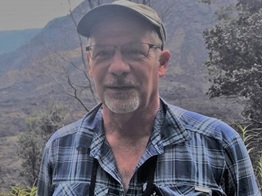 Steve Martin is an Environmental Scientist with the U.S. Army Corfps of Engineers’ Institute for Water Resources (IWR). His focus is on compensatory mitigation, including third party compensatory mitigation (mitigation banks and in-lieu fee programs). He provides technical and policy support to HQ USACE and Corps districts on compensatory mitigation. Much of his work has focused on education of Corps, federal, and state agencies in administrative and ecological aspects of compensatory mitigation. He also is the Corps’ national technical lead for RIBITS (Regulatory In-lieu fee and Bank Information Tracking System). Before coming to IWR he was a senior environmental scientist in the Norfolk District Regulatory Branch. He oversaw development and operations of a number of commercial mitigation banks.
Steve Martin is an Environmental Scientist with the U.S. Army Corfps of Engineers’ Institute for Water Resources (IWR). His focus is on compensatory mitigation, including third party compensatory mitigation (mitigation banks and in-lieu fee programs). He provides technical and policy support to HQ USACE and Corps districts on compensatory mitigation. Much of his work has focused on education of Corps, federal, and state agencies in administrative and ecological aspects of compensatory mitigation. He also is the Corps’ national technical lead for RIBITS (Regulatory In-lieu fee and Bank Information Tracking System). Before coming to IWR he was a senior environmental scientist in the Norfolk District Regulatory Branch. He oversaw development and operations of a number of commercial mitigation banks.

Michelle Mattson is a Stream and Wetland Ecologist with the U.S. Army Corfps of Engineers’ Institute for Water Resources (IWR) with over 20 years of professional experience as a consultant and regulator. Michelle is a compensatory mitigation subject matter expert (SME) and the IWR Regulatory Team budget manager. She supports national and regional training courses in compensatory mitigation and has spent her career in the field working with restoration teams to design, install and monitor restoration projects and programs. At the USACE, Michelle worked across agencies to develop the Advanced Permittee-Responsible Mitigation (APRM) Program for San Diego Association of Governments (SANDAG) and managed multiple banks and ILFs. As a consultant, she worked on two Special Area Managements Plans (SAMPs), the Otay River Watershed Management Plan, and several Mitigation Banks and ILF sites and multiple large-scale stream restoration projects in alignment with existing and planned USFWS habitat conservation plans (HCPs) and new SDRWQCB water quality requirements. She was a member of the California Wetland Monitoring Workgroup Level 2 (rapid assessment) Committee and was the first to use CRAM in evaluating impacts, alternatives analysis, and monitoring compensatory mitigation to improve decision making in LA District for several large alternative energy projects. Michelle remains a huge supporter of using functional and conditional assessments in regulatory and restoration practices including in informing the location and design of sites to short- and long-term monitoring performance and condition of sites.
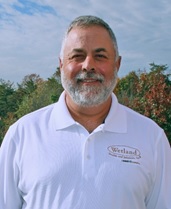 Michael (Mike) S. Rolband is the founder of Wetland Studies and Solutions, Inc. (WSSI), a 175+ person natural and cultural resources consulting firm headquartered in Gainesville, Virginia, and a subsidiary of The Davey Tree Expert Company. Mike founded WSSI in 1991 and pioneered its growth and expansion from the one-person wetlands consulting firm, to the multi-discipline natural and cultural resource consulting firm that today operates from four offices focused on permitting and regulatory requirements for the Clean Water Act, Chesapeake Bay Preservation Act, and Stormwater.
Michael (Mike) S. Rolband is the founder of Wetland Studies and Solutions, Inc. (WSSI), a 175+ person natural and cultural resources consulting firm headquartered in Gainesville, Virginia, and a subsidiary of The Davey Tree Expert Company. Mike founded WSSI in 1991 and pioneered its growth and expansion from the one-person wetlands consulting firm, to the multi-discipline natural and cultural resource consulting firm that today operates from four offices focused on permitting and regulatory requirements for the Clean Water Act, Chesapeake Bay Preservation Act, and Stormwater.
Mike is responsible for development of the first wetlands bank in Virginia in 1994 and the first mitigation bank to provide stream credits in Virginia in 2001. He also formed a non-profit to manage the Wetland Research Initiative, a research program that has funded $3.6 million in grants to several universities since 2007 – dedicated to advancing the state of the science of Mitigation. Between mitigation banks and permittee-responsible mitigation, WSSI has designed over 1,000 acres of wetland mitigation and over 280,000 linear feet of stream restoration projects.
Mike has served on the Chesapeake Bay Local Assistance Board and many state and local committees dealing with the Chesapeake Bay Preservation Act, stormwater regulations, and wetlands/stream regulations. In 2017 he accepted an appointment as a part-time Professor of Practice in the School of Civil and Environmental Engineering at Cornell University, and now invests his time and expertise teaching graduate students about the design and challenges of wetlands and stream restoration projects. Mike is an alumnus of Cornell, where he obtained his BS in Civil and Environmental Engineering, Master of Engineering (Civil), and MBA.
 Karen Greene is the Mid-Atlantic Field Offices Supervisor for National Oceanic and Atmospheric Administration, Fisheries Greater Atlantic Regional Fisheries Office’s (GARFO) Habitat Conservation Division and is also the GARFO Essential Fish Habitat Coordinator. She has been with NOAA Fisheries for more than 25 years, working primarily in the Mid-Atlantic region, especially in New York, New Jersey, Delaware and Pennsylvania. Her primary focus has been to provide advice and guidance to federal agencies on avoiding, minimizing and offsetting adverse impacts to coastal fish habitats through a number of consultation authorities such as the Magnuson Stevens Fishery Conservation and Management Act and the Fish and Wildlife Coordination Act. Karen has been involved in the evaluation of compensatory mitigation plans for more than two decades and participated on many interagency review teams (IRTs) for wetland mitigation banks, including the Meadowlands Interagency Mitigation Advisory Committee originally convened in 1998, as well as the IRTs for the first federally approved mitigation banks in NJ and NY. Karen is co-located at the NOAA Fisheries Northeast Fisheries Science Center at their James J. Howard Marine Science Laboratory at Sandy Hook, NJ. She has a BS and MS in Environmental Science, both from Rutgers University.
Karen Greene is the Mid-Atlantic Field Offices Supervisor for National Oceanic and Atmospheric Administration, Fisheries Greater Atlantic Regional Fisheries Office’s (GARFO) Habitat Conservation Division and is also the GARFO Essential Fish Habitat Coordinator. She has been with NOAA Fisheries for more than 25 years, working primarily in the Mid-Atlantic region, especially in New York, New Jersey, Delaware and Pennsylvania. Her primary focus has been to provide advice and guidance to federal agencies on avoiding, minimizing and offsetting adverse impacts to coastal fish habitats through a number of consultation authorities such as the Magnuson Stevens Fishery Conservation and Management Act and the Fish and Wildlife Coordination Act. Karen has been involved in the evaluation of compensatory mitigation plans for more than two decades and participated on many interagency review teams (IRTs) for wetland mitigation banks, including the Meadowlands Interagency Mitigation Advisory Committee originally convened in 1998, as well as the IRTs for the first federally approved mitigation banks in NJ and NY. Karen is co-located at the NOAA Fisheries Northeast Fisheries Science Center at their James J. Howard Marine Science Laboratory at Sandy Hook, NJ. She has a BS and MS in Environmental Science, both from Rutgers University.
![]()
View Past Compensatory Mitigation Training Webinars Here
View a List of Past Compensatory Mitigation Training Webinar Recordings Here

